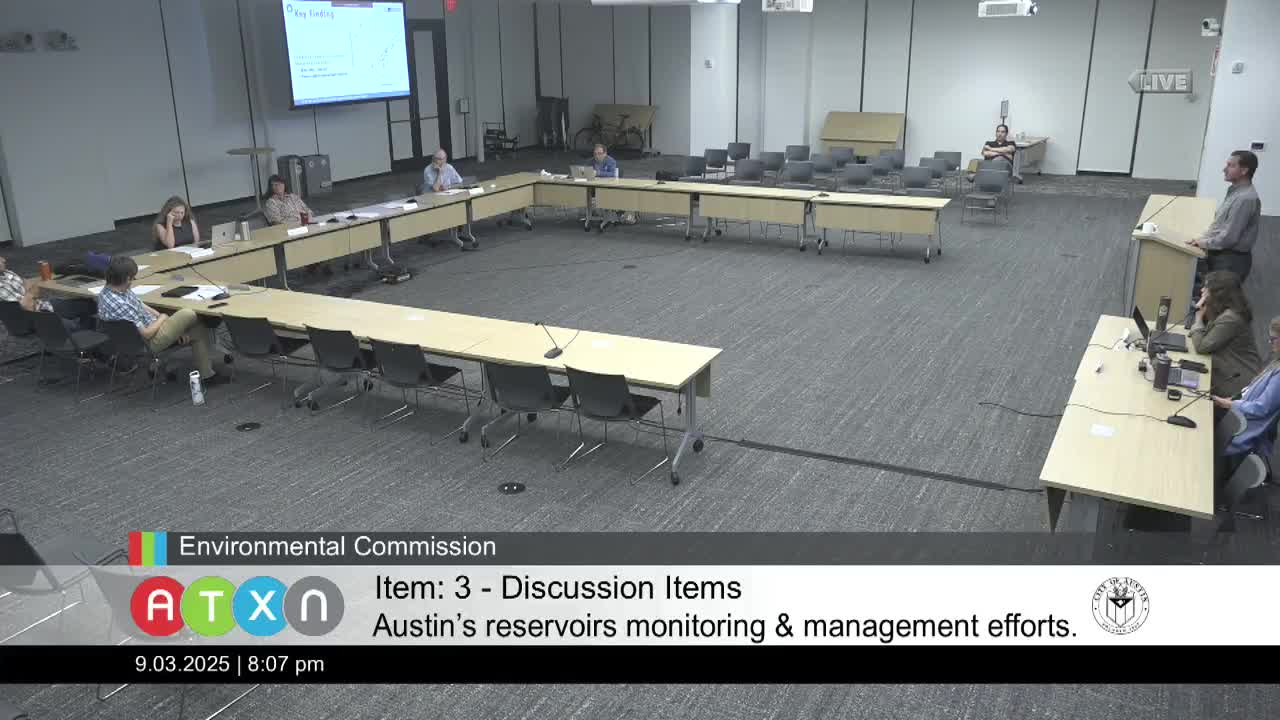Environmental Team Discusses Non-Native Hydrilla Impact and Water Quality in Austin
September 03, 2025 | Austin, Travis County, Texas
This article was created by AI summarizing key points discussed. AI makes mistakes, so for full details and context, please refer to the video of the full meeting. Please report any errors so we can fix them. Report an error »

The Austin Environmental Commission meeting held on September 3, 2025, focused on several critical environmental issues affecting the region, particularly concerning water quality and invasive species management.
The meeting began with discussions on compliance issues at various sites, with officials indicating that further evaluations would be conducted in collaboration with environmental enforcement teams. The potential repercussions for non-compliant sites remain to be determined, highlighting ongoing efforts to ensure environmental regulations are upheld.
A significant portion of the meeting was dedicated to the discussion of non-native hydrilla, an invasive aquatic plant. Concerns were raised about its rapid growth, which could obstruct water flow and potentially lead to flooding. The commission acknowledged the challenges in managing hydrilla due to resource constraints and the need to balance vegetation management with ecological health.
Commission members also inquired about the presentation of findings to the city council, emphasizing the importance of the information discussed. However, it was noted that no formal request had been made for such a presentation.
In terms of water quality, the commission explored comparisons with other major cities. While no direct comparisons were available, discussions included the establishment of water quality protective thresholds and the examination of urban water management practices in other regions. The commission highlighted the unique geological and land use characteristics of Austin, which complicate direct comparisons but allow for the identification of broader patterns in water quality trends.
Overall, the meeting underscored the importance of ongoing monitoring and management of Austin's water resources, with a focus on maintaining high ecological integrity. The commission expressed optimism about the region's water quality, noting that areas like Lake Austin and the surrounding green belts provide valuable habitats and resources. The meeting concluded with a commitment to continue addressing these environmental challenges and to keep the community informed about developments.
The meeting began with discussions on compliance issues at various sites, with officials indicating that further evaluations would be conducted in collaboration with environmental enforcement teams. The potential repercussions for non-compliant sites remain to be determined, highlighting ongoing efforts to ensure environmental regulations are upheld.
A significant portion of the meeting was dedicated to the discussion of non-native hydrilla, an invasive aquatic plant. Concerns were raised about its rapid growth, which could obstruct water flow and potentially lead to flooding. The commission acknowledged the challenges in managing hydrilla due to resource constraints and the need to balance vegetation management with ecological health.
Commission members also inquired about the presentation of findings to the city council, emphasizing the importance of the information discussed. However, it was noted that no formal request had been made for such a presentation.
In terms of water quality, the commission explored comparisons with other major cities. While no direct comparisons were available, discussions included the establishment of water quality protective thresholds and the examination of urban water management practices in other regions. The commission highlighted the unique geological and land use characteristics of Austin, which complicate direct comparisons but allow for the identification of broader patterns in water quality trends.
Overall, the meeting underscored the importance of ongoing monitoring and management of Austin's water resources, with a focus on maintaining high ecological integrity. The commission expressed optimism about the region's water quality, noting that areas like Lake Austin and the surrounding green belts provide valuable habitats and resources. The meeting concluded with a commitment to continue addressing these environmental challenges and to keep the community informed about developments.
View full meeting
This article is based on a recent meeting—watch the full video and explore the complete transcript for deeper insights into the discussion.
View full meeting
